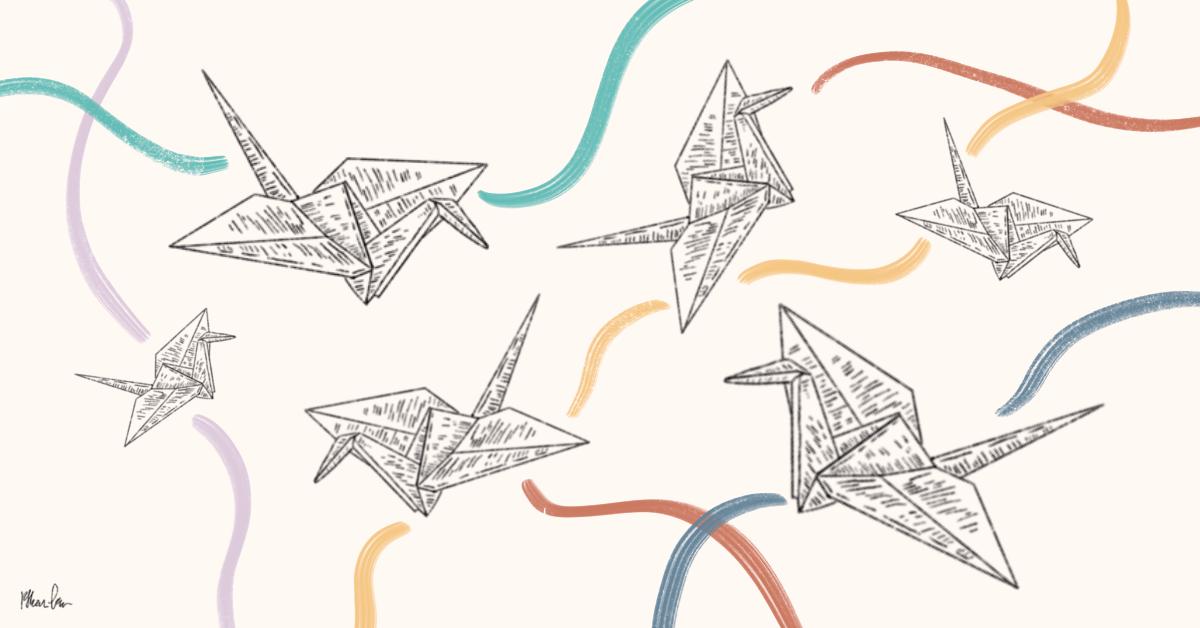By Sofia //
Paper cranes. When you first think of this traditional origami creation, most likely you’ll think of the Japanese folk saying about cranes. People say that when you fold a thousand paper cranes, you are given good fortune and granted one wish. However, I didn’t need that one wish: I just needed to believe in myself a bit more.
My journey started out when I was in my school counselling room, afflicted by anxiety.
My head pounded with tension, occupied by racing thoughts on a daily basis. I just could not focus in class, and I eventually found myself continuously visiting the counselling room, day by day, hoping to soothe these incessant thoughts.
I also had severe depression in which I sometimes felt that the world was collapsing on top of me. My life was one long greyscale. The teachers did try to encourage me to see the counsellors more often, to help manage my anxiety and depression better, but the space of the counselling room gave me no comfort. The walls were bare, and the space felt monotonous and dull. There was a small table in the corner, with some art supplies for the students to use, but for a long time I never touched those. I just sat on the couch. I took long, deep breaths. It was just me and my thoughts.
I visited the counselling room on many occasions after that. One particular day I had the sudden urge to try something new. I carefully slid out some paper from the small collection of art supplies in the corner of the room, and wondered if I could do something with it. I always loved visual arts. I constantly detested my anxiety. People also told me how creativity was one of my strengths, and how I could use it to my advantage to manage anxiety. Despite believing them on the surface, I still had to figure out how to end my ceaseless thoughts.
That same day, despite some apprehension, I attempted to fold the paper with an open mind. Little did I know that this act of folding paper would end up being my entire world.
The only thing I knew at that time was how to fold simple butterflies. However, I wanted to learn something else too. Thus, my journey to folding paper cranes began.
It wasn’t easy at first, I spent 30 minutes trying to figure out how to fold one paper crane. I wasn’t alone though. A friend and I learnt how to fold a crane together, funnily in the middle of a shopping mall. We watched a Youtube video together, earnestly trying to learn the folding technique, and following the steps one at a time. I still referred to the video from time to time when folding other paper cranes, but it became easier over time. I persisted, and slowly but surely I got better. I knew the steps by heart, and folding cranes became like a walk in the park to me. It almost felt as though my cranes came to life, looking at me with their twinkling eyes. I had a special connection with them, and they had a special connection with me, too. Soon enough, I had too many to keep on my desk. They were flooding my table, crammed together like peas in a pod. I could have just thrown them away. After all, I could easily make plenty more. However, my story does not end here. I had a marvellous idea to use them for a purpose, to decorate the counselling room. The burst of colour from the origami paper cranes transformed the mundane space into something much brighter.
The anxious, depressed, enervated girl that I was slowly transformed, too. She became much more open to trying new things. I wanted to make the paper cranes into mobiles, to hang up and share the joy of making with other people who visited the counselling room. I got permission from my school counsellor first, who strongly encouraged me on this small project of mine. I learnt how to sew the paper cranes together, to make a short chain. I initially started out with a chain of five cranes. This slowly became two chains, then three, four, and five, until eventually I had eight chains of cranes! I hung them up on a wooden shelf that they had in the counselling room, and stood back in awe. I called this project of mine – “Uplifting Cranes”. Not only had I created a delightful addition to the counselling room that had the potential to uplift others, but I had also learnt something profound about myself: I had the capacity to manage my anxiety and depression.
Focusing on something tangible allowed me to realise that negative thoughts do not last forever. They are never permanent, and they come and go just like the birds or cranes you see flying by you.
Remembering this metaphor allowed me to distance myself from the thoughts, and remember that creation is possible despite painful thoughts and emotions.
In the end, that is what truly mattered to me. It was not just about creating the cranes for fun, but allowing the skills hidden inside me all along to shine. I learned to try new things, and to believe in myself. Anxiety and depression can be like pesky little monsters inside your head. They can be very exasperating at times. If you are reading this, just know that you too are capable of managing them.



Sofia is a 17-year-old student. She loves learning about other people’s stories and increasing awareness about mental health. Sofia hopes to contribute to a more empathetic society that supports people with mental health conditions.
Read more of our Tapestry Stories here.
Illustration by Ethan.

